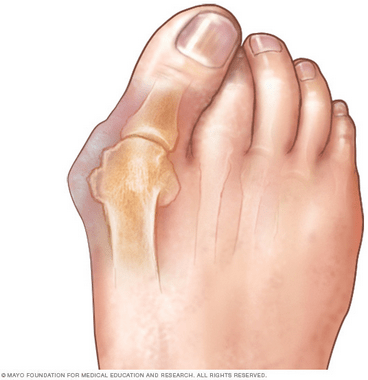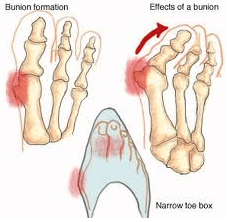Hallux Valgus (Bunions)
Hallux Valgus, commonly referred to as a bunion, is seen as a bump at the base of an awkwardly angled big toe joint (seen below). The bump happens when the big toe angles towards the next toe, causing a deformity at the 1st Metatarsal joint, the joint that connects the big toe to the foot. Swelling at the joint, as well as pain that worsens when wearing narrow footwear, may develop.

Causes
Bunions, or Hallux Valgus, can be the result of multiple factors. Some of them may include:
- Narrow footwear or high heels
- Inherited genetics
- Overpronation
- Foot injuries
Bunions can become an issue at practically any stage of life. They can be due to weakness of the connective tissue and are encouraged by narrow footwear and high heels.

Symptoms
Symptoms are indicators of a problem and for bunions, some of them may include:
- A bump on the big toe joint
- Swelling/soreness at the joint
- Painful in general but worse when wearing narrow shoes
- An overlap of the first and second toe (sometimes with callouses)
The growth of a bunion is progressive in that you will first see the deformation growing before you feel the pain. Treating the bunion before it becomes painful is advisable.
Treatment
Unless treated early, where the growth of the toe can be redirected to the correct position with orthotics, the treatment for bunions is surgery. Additionally, in order to prevent the bunions from reoccurring, custom orthotics and the proper footwear are highly effective long-term solutions post-surgery.
- Custom orthotics work by supporting the body’s frame through the foot. This is done by realigning the ankle and lower legs in order to correct the motion of the foot. In the case of bunions, Rite Gait’s handcrafted custom orthotics will be designed to distribute your body weight around the bunion and cushion the forefoot correctly. They will specifically be designed to lift and support the foot in areas that are able and reduce pressure on areas that are sensitive in order to help you become pain-free.
- The proper footwear is important when it comes to living with or treatment of bunions. Specifically, the footwear must not compress the toes, have a well-cushioned sole and have adequate spacing so as not to press against the joint. They may also include a forefoot rocker sole in order to minimize the joint bending.
At Rite Gait, our pedorthists will handcraft your custom orthotics and help you find the perfect footwear in order to treat your bunions. They can also modify the footwear to fit your needs such as widening the toe area to provide spacing for bunions.
MILTON LOCATION
- 335 Main St E, Milton, ON L9T 1P5
- (905) 876-1095
- ritegait@gmail.com
- WEEKDAYS: 10 AM - 6 PM
SATURDAYS: 9:30 AM - 2:30 PM
SUNDAYS: Closed